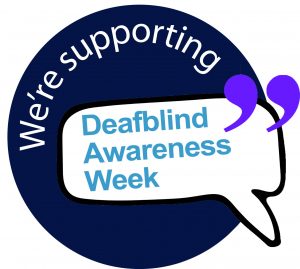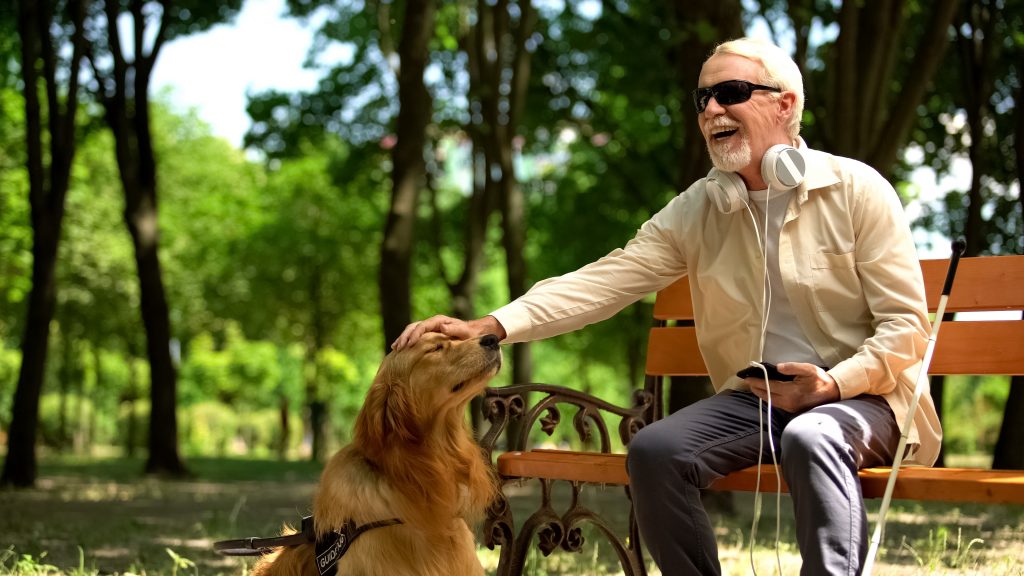Imagine being in a crowded nightclub with loud, chaotic music and very poor lighting. A friend is standing nearby asking what you’d like to drink. You’re trying your hardest to hear what they’re saying, whilst paying even more attention to those dancing around you so that you don’t accidentally stand on someone’s foot. For some people, this is what it’s like living with deafblindness every day.
What is deafblindness?
This week, we are shining a spotlight on an incredibly misunderstood disability. Deafblindness refers to the loss of sight and hearing to a point where your communication, mobility and access to information are impacted.[i] This includes progressive sight and hearing loss, where a person’s sight and hearing may deteriorate over a period of time. Deafblindness is often also referred to as dual sensory loss or dual sensory impairment.
It is estimated that there are nearly 400,000 deafblind people in the UK, with this figure expected to increase to over 600,000 by 2035 due to our aging population.[ii] Deafblindness affects people of all ages – including children and young people – but it is more common in older people, as our sight and hearing naturally deteriorates as we get older. There are two broad types of deafblindness:
- Congenital deafblindness is a term used if a person is born with a sight and hearing impairment. This may be due to infections during pregnancy, premature birth, birth trauma and rare genetic conditions.
- Acquired deafblindness is a term used if a person experiences sight and hearing loss later in life. Anyone can become deafblind at any time through illness, accident or as a result of aging.
Busting myths
Although deafblindness is more common than you might think, there are many misconceptions surrounding this disability, primarily arising from a lack of understanding when it comes to the wide spectrum of health issues that can lead to hearing and sight loss. For instance, being deafblind doesn’t necessarily mean that you are totally deaf or blind – most people who are deafblind have some residual sight and/or hearing.
Deafblindness can ultimately affect people in different ways. The extent to which it may affect someone’s daily life depends on a number of factors, including the nature of their sight and hearing loss, the cause of their deafblindness, other medical conditions they may have, as well as the individual’s own attitude, personality and experiences. Some people with deafblindness may need to adjust the settings on their TV or turn up the volume on their phone, whilst others might require assistance dogs, canes and more advanced support in order to carry out day-to-day tasks.
Barriers to support
According to a report from the World Federation of the Deafblind (WFDB), those with deafblindness are more likely to be poor and unemployed, with lower educational outcomes. As such, they may struggle to obtain the right support for their condition and are often excluded from both development and disability programmes.[iii]
The reality is that for people whose sight and hearing is restricted, it may be difficult communicating and interacting with those around them. Limited information of what is happening can influence their ability to understand and make sense of their environment, resulting in a breakdown in communication. In turn, the individual can feel isolated and detached from people, places and sources of information, with the potential for them to become withdrawn and depressed, which can result in more serious mental health issues.
Adapting our approach
We at Ambulance Transfers Ltd (ATL) are advocates for improved understanding of deafblindness in order to make life a little easier for people who are affected by the condition. As a patient transport provider, we regularly engage with large and diverse groups of people, including those with sight and/or hearing impairments. As such, we do everything we can to provide an exceptional service that caters to the unique needs and preferences of each patient.
Our road crews are specifically trained to adapt how they communicate in order to support people with deafblindness. Some of these communication techniques include:
- Standing in front of the patient and speaking clearly and slowly to enable them to lipread (our road crews are required to lower their facemasks in this case)
- Using gestures and facial expressions to support what is being said
- Using the deafblind manual alphabet – a tactile form of communication where words are spelt onto the patient’s hand using set positions and movements
- Using British Sign Language (BSL) or hands-on BSL, which involves the patient feeling the signer’s hands
- Using technology (e.g. smartphones or tablets) to help explain or reinforce what is being said
- Ensuring information is accessible through large print, Braille or audio formats
- Ensuring our vehicles are stocked with hearing loops to support the use of hearing aids
Do your bit
Deafblindness can be challenging to live with, but it doesn’t have to be a burden. It’s important that we all do our bit to ensure those with sight and/or hearing loss are provided the right support to suit them. Tell us your deafblind story in the comments below – we’d love to know about your experiences!
For more information, visit www.deafblind.org.uk
REFERENCES
[i] Deafblind UK. (2021) What is Deafblindness?. Available at: https://deafblind.org.uk/information-advice/what-is-deafblindness/.
[ii] Sense. (2021) What is deafblindness?. Available at: https://www.sense.org.uk/get-support/information-and-advice/conditions/what-is-deafblindness/.
[iii] World Federation of the Deafblind. (2018) At risk of exclusion from CRPD and SDGs implementation: Inequality and Persons with Deafblindness. Available at: http://www.wfdb.eu/wp-content/uploads/2019/04/WFDB-global-report-2018.pdf.



Leave A Comment